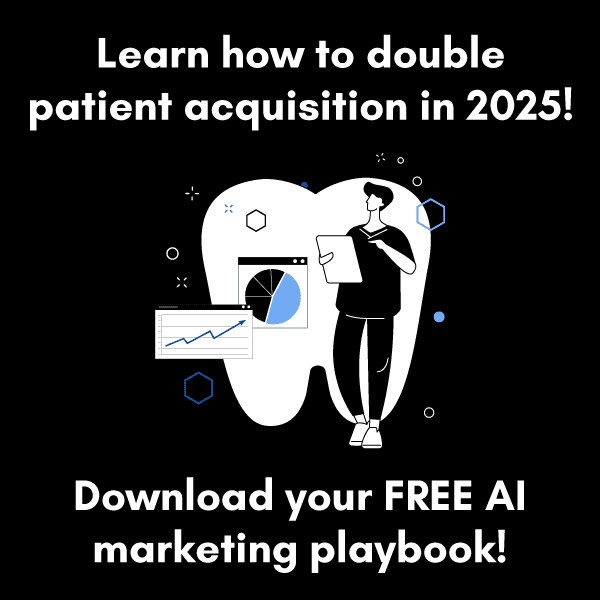
Author: Jesse Davis | Co-Founder & CEO of ViziSites
Table of Contents
Key Takeaways
- Understanding dental SEO is crucial as 77% of patients search online before booking appointments, making digital visibility essential for practice growth.
- Local SEO tactics like optimizing your Google Business Profile and earning patient reviews can put you ahead of 90% of dental competitors.
- Creating helpful, patient-focused content that answers real questions will establish your practice as the trusted authority in your area.
- Unlike paid ads that stop working when you stop paying, dental SEO provides compounding returns that grow stronger over time.
- Following ethical SEO practices protects your professional reputation while building sustainable online visibility that attracts quality patients.
You’re an excellent dentist with years of experience, yet new patients keep choosing your competitors down the street. Sound familiar?
Here’s the harsh truth: in today’s digital age, clinical excellence alone won’t fill your appointment book. While you’re focused on providing quality care, your competitors are dominating Google searches, capturing patients before they even know you exist.
This is where understanding SEO becomes your practice’s lifeline. Dental SEO (search engine optimization) is the strategic process that makes your practice visible to the 77% of patients who search online before booking their dental appointments.
It ensures when someone searches for “dentist near me” or “emergency tooth repair,” they find you first. Master this to transform from hidden gem to market leader.

Understanding What Is Dental SEO: The Basics
Let’s Break Down What Dental SEO Really Means
So what exactly is dental SEO? Think of it as your practice’s digital megaphone.
When someone types “dentist near me” or “fix broken tooth fast” into Google, dental SEO determines whether they’ll find your practice or end up at your competitor’s office. It’s the art and science of making your website irresistible to both search engines and potential patients.
Here’s how it works: You optimize your website’s content, structure, and online presence to match what Google considers trustworthy and relevant. Let’s say someone searches for “emergency dentist in Brooklyn” – if you’ve done your SEO homework, your practice pops up right at the top.
No SEO? You’re invisible, even if you’re the best emergency dentist in Brooklyn.
Google evaluates these key ranking factors:
- Website speed (because nobody likes waiting)
- Mobile compatibility (since that’s where most people search)
- Quality backlinks (other reputable sites linking to yours)
- Patient reviews (real feedback from real patients)
- Content quality (helpful, accurate information)
It’s like a digital reputation scorecard, and you want to ace it.
The Two Sides of the Dental SEO Coin
Dental SEO breaks down into two main parts: what you do on your website (on-page) and what happens everywhere else online (off-page). Let me show you what I mean.
On-page optimization is everything within your control on your actual website:
- Writing helpful content about procedures
- Including keywords patients actually search for
- Crafting compelling page titles and descriptions
- Ensuring lightning-fast page load times
- Making navigation intuitive and user-friendly
It’s like making your practice’s digital home welcoming and informative.
Off-page optimization is about building your reputation across the internet:
- Earning links from reputable websites (digital referrals)
- Managing patient reviews across platforms
- Maintaining consistent practice information everywhere
- Building relationships with local organizations
- Creating shareable resources others want to reference
When the local newspaper’s health section links to your wisdom tooth article? That’s off-page SEO gold.

Why Your Dental Practice Needs SEO (Like, Yesterday)
Patients Have Gone Digital – Have You?
Remember when new patients came mostly from word-of-mouth referrals? Those days are gone.
Today’s patients hit Google before they ask their neighbor. In fact, over one billion health-related searches happen on Google every single day. Yes, billion with a ‘B’.
Your potential patients are searching for everything:
- “How much do veneers cost”
- “Is teeth whitening safe”
- “Dentist open on Saturday”
- “Emergency tooth pain relief”
- “Best dentist for anxious patients”
If you’re not showing up in these searches, you’re basically invisible. It’s like having the best dental practice in town but hiding it in an unmarked building down a dark alley.
Here’s what really matters: Studies prove that good SEO directly leads to more patient appointments. When you appear at the top of search results, more people call your office.
It’s not magic – it’s just being where your patients are looking. The higher you rank, the more patients you attract. Simple as that.
Building Trust Before They Even Meet You
Showing up in searches does more than attract eyeballs – it builds trust.
When patients consistently see your practice at the top of Google results, their brain makes a simple connection: “This must be a good dentist.” Add helpful content that actually answers their questions? Now you’re not just a dentist; you’re their trusted dental advisor.
Think about your own behavior. When you search for something and see the same business repeatedly at the top, providing useful information, don’t you automatically trust them more?
Your patients think the same way. A strong online presence says, “We’re established, we’re credible, and we know what we’re doing.”
The Marketing Investment That Keeps on Giving
Here’s where SEO really shines compared to other marketing. Stop paying for ads, and your phone stops ringing immediately.
But SEO? It’s like planting a tree that keeps bearing fruit year after year. Sure, you need to water and tend it, but once it’s established, it keeps delivering patients without constant cash infusions.
You’re not paying per click or per view. Instead, you’re earning visibility by being genuinely helpful and relevant online.
In competitive markets (and let’s face it, what dental market isn’t competitive?), strong SEO gives you the edge. While others throw money at ads, you’re building a sustainable patient pipeline.
Your Dental SEO Playbook: Strategies That Actually Work
Local SEO: Becoming Your Neighborhood’s Go-To Dentist
Since nobody’s flying across the country for a teeth cleaning, local SEO is your bread and butter. You want to dominate when people search for “dentist near me” or “emergency dentist in [your city].”
Step 1: Master Your Google Business Profile
First up: claim and optimize your Google Business Profile. It’s free, and it’s probably the single most important thing you can do today.
Essential Google Business Profile optimizations:
- Fill out every single section completely
- Add high-quality photos (waiting room, treatment rooms, your team)
- List accurate hours and update them for holidays
- Add attributes like “wheelchair accessible” or “accepts new patients”
- Post updates weekly about offers or dental tips
- Respond to messages quickly
When your info is wrong or missing, patients go elsewhere – and fast.

Step 2: Nail Your Local Citations
Get serious about local citations. That means making sure your practice appears in every relevant local directory:
- Yelp
- Healthgrades
- Vitals
- Local chamber of commerce
- Neighborhood Facebook groups
- Medical directories
But here’s the catch – your name, address, and phone number must be exactly the same everywhere. “Smith Dental” on Google but “Smith Dental Care” on Yelp? That confusion hurts your rankings.
Step 3: Location-Specific Content That Converts
Sprinkle location-specific keywords throughout your website naturally. Don’t just write about “dental implants” – write about “dental implants in downtown Portland” or “affordable root canals near University District.”
Create location pages for each area you serve. If you pull patients from three neighboring towns, create a page for each:
- “Dental Services in Westfield”
- “Your Trusted Dentist in Springfield”
- “Emergency Dental Care in Riverside”
But here’s the key: make it sound natural and provide unique, valuable content for each location.
Step 4: Turn Reviews Into Ranking Rocket Fuel
Reviews are local SEO rocket fuel. Happy patients leaving 5-star reviews? That’s gold. But you need a system.
Creating a review-generating machine:
- Train your team to ask at the right moment (after a great appointment)
- Send follow-up texts with direct review links
- Make it stupid-easy – one click to leave feedback
- Respond to every single review within 24-48 hours
- Thank positive reviewers by name
- Address criticism professionally and publicly
Here’s what most dentists miss: Google notices engagement. Your responses show you’re an active, caring practice.
Creating Content That Search Engines (and Patients) Love
Google loves websites that actually help people. So here’s your mission: become the most helpful dental resource in your area.
Service Pages That Actually Sell
Start by creating detailed pages for each service you offer. Don’t just list “crowns” – explain everything a nervous patient might wonder about at 2 AM.
What every service page needs:
- What the procedure is (in plain English)
- Who needs it and why
- Step-by-step process explanation
- Recovery time and aftercare
- Cost ranges and insurance info
- Before/after photos (with permission)
- FAQs specific to that procedure
- Clear next steps for booking
Your dental implant page shouldn’t just say “We do implants.” It should answer every possible question:
- What’s the difference between implants and bridges?
- How long do implants last?
- What’s the surgery like?
- Can you eat normally afterward?
- How much do they cost with and without insurance?
Blog Topics That Attract Ideal Patients
Launch a blog where you answer the questions you hear every day. Every question is a blog post opportunity.
High-performing dental blog topics:
- “Why Do My Gums Bleed? 5 Causes and Solutions”
- “How to Know If You Need a Root Canal: Warning Signs”
- “That Weird Taste in Your Mouth: What It Means”
- “Dental Emergency or Can It Wait? A Decision Guide”
- “The Real Cost of Skipping Your Dental Checkup”
Write like you’re explaining to a friend, not lecturing to dental students.
Content Goldmines Most Dentists Ignore
Here’s where you can really stand out:
Procedure prep guides:
- “How to Prepare for Your Wisdom Tooth Extraction”
- “What to Eat After Oral Surgery: Day-by-Day Guide”
- “Managing Dental Anxiety: Tips from Our Patients”
Seasonal content that gets shared:
- “Back-to-School Dental Checkup Checklist”
- “Holiday Treats That Won’t Wreck Your Teeth”
- “New Year, New Smile: Using Benefits Before They Expire”
Insurance and cost guides:
- “Understanding Your Dental Insurance: A Plain English Guide”
- “Payment Plans and Financing: How to Afford Dental Care”
- “FSA/HSA for Dental: What’s Covered?”
Keeping Content Fresh and Ranking
Google notices when websites gather dust. Set calendar reminders to review your top pages every quarter.
Content refresh checklist:
- Update statistics and research findings
- Add new patient testimonials
- Refresh photos and graphics
- Update insurance and pricing info
- Add new FAQs based on patient questions
- Link to newer related content
Show both Google and patients that you’re actively engaged, not just set-it-and-forget-it.

Making Your Website Lightning Fast and Mobile-Friendly
Nobody waits for slow websites anymore. If your site takes more than three seconds to load, you’ve already lost half your visitors.
Speed Optimization That Actually Matters
Quick wins for faster loading:
- Compress images (do you really need that 10MB waiting room photo?)
- Choose quality hosting with good server response times
- Remove unnecessary plugins and widgets
- Enable browser caching
- Minimize code and scripts
Test your speed regularly using free tools:
- Google’s PageSpeed Insights
- GTmetrix
- Pingdom
These tools tell you exactly what’s slowing you down.
Mobile Optimization Is Everything
Most of your patients search on their phones while sitting in traffic or waiting in line at Starbucks. Your site needs to look amazing and work perfectly on every screen size.
Mobile must-haves:
- Thumb-friendly buttons and navigation
- Clickable phone numbers for instant calling
- Forms that are easy to fill without zooming
- Text that’s readable without pinching
- Fast loading on cellular networks
- No horizontal scrolling required
Test everything on actual phones, not just by shrinking your browser window.

Site Architecture That Converts
Don’t forget the basics: organize your site logically. Patients should find what they need in three clicks or less.
Navigation best practices:
- Use clear menu labels (not clever ones)
- Group related services together
- Include a search function
- Add a sticky header with phone number
- Create clear paths to booking appointments
- Include breadcrumbs for easy navigation
Make it so easy to navigate that even your tech-challenged uncle could book an appointment.
Building Your Dental Practice’s Online Authority
Think of links from other websites as digital word-of-mouth referrals. When the local health blog links to your article about preventing cavities, Google sees that as a vote of confidence.
Strategic Link Building That Works
But not all links are equal – one link from your state dental association beats 50 links from random directories.
High-value link opportunities:
- Guest posts on local health websites
- Expert quotes in news articles
- Professional association directories
- Local business partnerships
- Community event sponsorships
- Healthcare provider networks
Turning Community Involvement Into Links
Get strategic about professional connections:
Media opportunities:
- Sign up for HARO (Help a Reporter Out)
- Respond to dental health queries
- Offer expert commentary on studies
- Provide quotes for health articles
- Write opinion pieces for local papers
When the local news needs a dentist’s perspective on fluoride in water or the latest dental health study, be their go-to expert.
Creating Link-Worthy Resources
Create resources other people want to share:
- Comprehensive guides (“Complete Guide to Dental Insurance in [Your State]”)
- Interactive tools (cost calculators, quiz widgets)
- Downloadable resources (“Dental Emergency First Aid Guide”)
- Infographics (“The Real Cost of Skipping Dental Visits”)
- Research summaries in plain English
While building quality links takes time, avoid these dangerous shortcuts:
What NOT to Do
Whatever you do, don’t buy links or use shady tactics. I know it’s tempting when someone emails offering “1000 quality backlinks for $99!”
But Google’s too smart for that now. Getting caught can destroy your rankings overnight. One penalty can take months or years to recover from.
Focus on earning links through being helpful, involved, and creating share-worthy content.

Creating an Experience That Converts Visitors to Patients
Getting people to your website is only half the battle. You need them to pick up the phone and book an appointment.
Monitoring What Matters
Watch your bounce rate – that’s the percentage of people who leave after viewing just one page.
The American Dental Association says anything over 60% needs attention. High bounce rate? Something’s wrong:
- Maybe your site’s confusing
- Maybe it’s not mobile-friendly
- Maybe it’s not giving people what they expected
Making Action Irresistible
Make taking action brain-dead simple:
Conversion essentials:
- Phone number at the top of every page
- “Book Appointment” buttons that actually work
- Multiple contact options (phone, form, text)
- Live chat for immediate questions
- Clear office hours and location
- Emergency contact information
The easier you make it to become a patient, the more likely visitors will convert.
Engagement Features That Work
Add features that keep people engaged:
- Virtual consultation options
- Treatment cost estimators
- Patient testimonial videos
- Virtual office tours
- Before/after galleries
- Insurance verification tools
These interactive elements keep visitors on your site longer while providing genuine value. They also differentiate your practice from competitors who offer only basic websites.
Your Step-by-Step Dental SEO Action Plan
Start With an Honest SEO Audit
Before you change anything, figure out where you stand. It’s like taking x-rays before treatment – you need to see what’s really going on.
Week 1: Technical audit
- Run your site through Google’s PageSpeed Insights
- Test mobile-friendliness with Google’s tool
- Check for broken links and 404 errors
- Verify your SSL certificate is active
- Review your XML sitemap
Week 2: Content audit
- List all your current pages
- Identify thin or duplicate content
- Find gaps in your service offerings
- Check keyword usage and placement
- Assess content freshness dates
Week 3: Competitive analysis
- Google your main services
- Note who ranks in top 3
- Analyze their content depth
- Check their review counts
- Study their site structure
Week 4: Local presence audit
- Google your practice name
- Check citation consistency
- Review your Google Business Profile
- Audit directory listings
- Assess review quantity and quality
Build Your Content Machine
Create a content calendar that works with your schedule. Consistency beats frequency every time.
Monthly content planning:
- Week 1: Service page update or creation
- Week 2: Blog post on common patient question
- Week 3: Seasonal or timely content
- Week 4: Review and refresh old content
Content creation system:
- Keep a running list of patient questions
- Record yourself answering them
- Transcribe and edit for clarity
- Add relevant keywords naturally
- Include helpful images and graphics
- Publish and promote
Set up a system that works. Maybe you dictate blog posts while driving between offices. Maybe your hygienist who loves to write takes it on. Whatever works – just make it consistent and sustainable.
Track What Matters (And Ignore What Doesn’t)
Install Google Analytics if you haven’t already. It’s free and shows you exactly what’s happening on your website.
Key metrics to monitor monthly:
- Organic traffic growth
- Top landing pages
- Conversion rate (visitors to contacts)
- Average time on site
- Bounce rate by page
- Mobile vs. desktop usage
Patient acquisition metrics:
- Phone calls from Google
- Online appointment bookings
- Contact form submissions
- New patient appointments from web
- Revenue from online sources
Set up monthly check-ins with yourself or your team. Review what’s working, what’s not, and what to try next.

Playing by the Rules: Ethical SEO for Dentists
Keep It Honest and Transparent
Your dental license comes with ethical obligations that extend online. Every word on your website, even the hidden stuff Google reads, must be truthful.
Ethical guidelines to follow:
- Never claim specializations you don’t have
- Don’t promise results you can’t deliver
- Avoid superlatives (“best dentist”) without proof
- Be transparent about costs and procedures
- Respect patient privacy in all content
You can’t claim to be a specialist if you’re not. You can describe services you offer, like “orthodontic procedures,” but be clear about your qualifications.
The American Dental Association’s ethics code covers online marketing just like traditional advertising. Deceptive SEO tactics aren’t just unethical – they can get you in serious professional trouble.
Put Patients First in Everything You Create
Every piece of content should help patients, not just attract clicks.
Patient-first content principles:
- Focus on education, not fear
- Present balanced information
- Respect patient intelligence
- Use clear, simple language
- Include all options, not just expensive ones
- Address common concerns honestly
Skip the fear-mongering. Don’t write “You’ll lose all your teeth if you don’t get this treatment NOW!” Present information that helps patients make informed decisions.
Own Your Online Reputation
If you hire an SEO company, you’re still responsible for what they do. Many SEO agencies don’t understand healthcare regulations.
Managing SEO partnerships:
- Set clear ethical boundaries upfront
- Demand transparency about all tactics
- Review all content before publishing
- Maintain final approval rights
- Monitor their work regularly
- Fire them if they suggest shady tactics
Regularly audit your online presence. Google your practice, read what others write about you, check that all content meets your standards.
Rookie Mistakes That Kill Your Dental SEO
Ignoring Your Local Market
Some dentists get so focused on ranking for “dentist” that they forget about “dentist in Maple Grove” or “emergency dentist near downtown.”
Local SEO mistakes:
- Inconsistent NAP (name, address, phone)
- Neglected Google Business Profile
- No location-specific content
- Missing local schema markup
- Ignoring local directories
- No community involvement
Nobody’s driving 50 miles for a cleaning. Local SEO is where you win or lose.
Creating Weak, Duplicate Content
Google hates thin content – those pages with 100 words that say nothing useful.
Content mistakes to avoid:
- Multiple similar pages with slight variations
- Copying content from other sites
- Keyword stuffing that sounds robotic
- No unique value proposition
- Outdated or incorrect information
- No clear call to action
Write original content for every page. Yes, it’s more work. But it’s the only way to rank well.
Obsessing Over Rankings Instead of Patients
Here’s a truth bomb: ranking #1 for “dentist” means nothing if those visitors don’t become patients.
Conversion mistakes:
- Hiding contact information
- Complicated appointment booking
- No trust signals (certifications, reviews)
- Poor user experience
- No clear value proposition
- Focusing on you instead of patient benefits
Balance SEO with user experience. Rankings get them to your door – conversion gets them in your chair.
The Future of Dental SEO Is Already Here
Voice Search Changes Everything
“Hey Siri, find a dentist near me who’s open on Saturdays.” That’s how your future patients search.
Optimizing for voice search:
- Use conversational language
- Answer complete questions
- Include FAQ sections
- Target long-tail keywords
- Focus on local queries
- Optimize for featured snippets
Think about how someone would ask a friend for a dentist recommendation, then make sure your content matches that natural language.
AI Makes Search Smarter Every Day
Google’s getting scary-smart at understanding what people really want. It’s less about gaming the system with keywords and more about genuinely being the best answer.
Preparing for AI-driven search:
- Create comprehensive content
- Focus on user intent
- Build topical authority
- Improve user experience
- Use structured data
- Prioritize E-A-T (expertise, authority, trust)
The practices providing real value will win.
Technology and Patient Care Merge
The line between marketing tech and patient care tech is disappearing.
Tech trends affecting SEO:
- Online scheduling (keeps people on-site longer)
- Virtual consultations (engaging content)
- Patient portals (return visits)
- Chatbots (24/7 engagement)
- Review automation (fresh content)
- Video content (higher engagement)
Every patient touchpoint impacts your SEO. Invest in technology that serves patients and search engines simultaneously.

Your Burning Questions About What Is Dental SEO, Answered
How long until I see real results from dental SEO?
Buckle up – SEO is a marathon, not a sprint. You’ll typically see meaningful results in 3-6 months. Think of it like orthodontics – gradual movement leads to lasting results.
Should I tackle dental SEO myself or hire pros?
You can handle basics like content creation and Google Business Profile management. But technical SEO and comprehensive strategy? That’s where pros earn their keep. If hiring help, ensure they understand healthcare marketing rules.
What's a reasonable dental SEO budget?
Investment ranges from a few hundred to several thousand monthly. View it as patient acquisition cost – if $500/month brings 10 new patients worth $2,000 each, that’s a 40x return. Start small and scale with results.
Does social media actually help with dental SEO?
Not directly. But social media drives website traffic, builds brand awareness, and can earn you links. Plus, active social profiles often appear in search results for your practice name.
How is dental SEO different from regular SEO?
Dental SEO emphasizes local search, healthcare-specific keywords, and strict advertising regulations. You can’t make claims a pizza shop could. Plus, trust matters more when asking someone to let you drill in their mouth. HIPAA and state regulations affect everything.
How do I measure if my dental SEO actually works?
Track what matters: organic traffic, keyword rankings, phone calls from Google, and new patient appointments from online sources. If SEO isn’t filling chairs, adjust your strategy.
Should I target broad or specific procedure keywords?
Both! “Dentist near me” casts a wide net, while “wisdom tooth extraction cost” attracts ready-to-book patients. Start with procedures you excel at, then expand.
Will bad reviews tank my dental SEO?
Not if handled properly. A few negative reviews among positive ones looks authentic. Respond professionally, fix legitimate issues, and keep earning positive feedback. Maintain 4+ stars overall.
The Bottom Line on Dental SEO
Understanding SEO isn’t just about learning marketing buzzwords – it’s about securing your practice’s future. In a world where patients search online before choosing a dentist, being invisible online means being invisible, period.
The good news? You don’t need to become an SEO expert overnight.
Start where you are. Claim your Google Business Profile today. Write one helpful blog post this week. Make sure your website works on phones.
These small steps compound into major results. Remember, successful dental SEO isn’t about tricking Google – it’s about being genuinely helpful to patients searching for dental care.
Focus on serving your community online just like you do in your office, and watch your practice grow.

About the Author:
Jesse Davis
Co-Founder & CEO of ViziSites
Jesse has been on the cutting edge of healthcare marketing for two decades, first catapulting iMatrix from a handful of clients to thousands of practice owners by building high-performance teams and forging strategic partnerships, then launching the veterinary division at ProSites and providing a foundation that scaled it nationally. Today he leads ViziSites, where he and his team harness a “tsunami” of AI-driven data to turn complex signals into clear, measurable growth for practice owners nationwide. A 4th-degree Brazilian Jiu-Jitsu black belt and outspoken mentor, Jesse channels the same discipline from the mat into empowering young founders and helping thousands of practices dominate local search while demystifying the future of AI in practice marketing.










